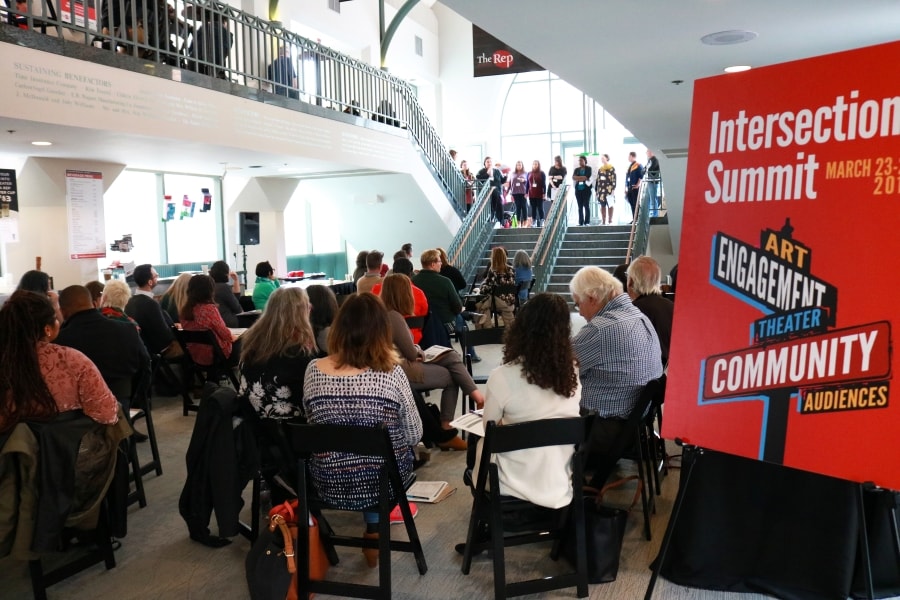Late in March, Milwaukee Repertory Theater hosted a convening called the Intersections Summit. Inspired in part by Theatre Communications Group’s previous Audience (R)Evolution convenings in Philadelphia and Kansas City, Intersections’ purpose was to gather practitioners for reflection and collaboration, recognizing that this work increasingly intersects with so many people in our theatres and our communities. Framed with a strong Equity, Diversity, and Inclusion focus, the meeting kicked off with artEquity founder and director Carmen Morgan’s energized and compelling keynote, in which she urged the room to think about their mandate not simply as community engagement, but as community justice work—with justice being the operative word. Her words rang out as a call to examine the values, relationships, and structures that can produce the most effective spaces for partnerships to thrive—whether these partnerships are related directly to the work onstage, expanding community conversations, or engaging young people through programs in the classroom. This consciousness and these values are already fundamental to the work of some theatre practitioners, but they have expanded exponentially of late.
As the convening proceeded, I learned of a wide range of programs and philosophies, including how theatre leaders are encouraging more inclusive cultures. What struck me most, though, were a few accounts of the ways theatres and teaching artists are working toward a much larger sense of civic engagement and community justice among young people.
Along those lines, I serendipitously landed in a workshop with Beginner’s Guide to Community-Based Arts author Mat Schwarzman and the University of Wisconsin-Milwaukee’s Joëlle Worm, titled Training K-12 Teachers to Engage With the Arts. While I hadn’t originally intended to take part in this session—I took a wrong turn in the hallway—I’m glad I stayed. Through role-playing exercises, the facilitators taught us how a triangular team made up of a community organizer, an artist, and a teacher can work together to center students in creating artistic responses to urgent community issues. My team, which identified itself as working in a 7th-grade classroom, decided to make a theatre piece on the Second Amendment. I drew the “teacher” card. Taking on the persona of the “teaching artist” was American Theatre staff writer Allison Considine (who reports more fully on Intersections here). Our “community organizer” was a representative from an anti-gun violence organization. I left the session with some important new perspective and a greater sense of hope—a hope realized as I witnessed the March for Our Lives taking place that weekend just outside the Rep.
Another important encounter was with Maria Asp, a longtime teaching artist at Minneapolis’s Children’s Theatre Company in the Neighborhood Bridges program. Bridges was designed more than 20 years ago to help improve language and literacy outcomes for students, and to build more rigorous, culturally responsive classroom environments. Maria was eager to tell me about a new curriculum that centers Muslim voices to foster a better cultural understanding between Muslim and non-Muslim students. Minneapolis is home to the largest Somali community in the U.S., and these community members experience Islamophobia every day, from being targeted for surveillance by the FBI to suffering attacks on their places of worship. Mothers report to Neighborhood Bridges staff that they observe profound internalized oppression in their children, including one mom whose 5-year-old doesn’t want to write his last name for fear that people will find out he is Muslim.
Though historically the Bridges program has focused its curriculum on global folk and fairy tales as a touch point for exploring present-day experiences, CTC has begun building a curriculum of stories that address the experiences of young people. According to the theatre, these stories are created within the context of two dynamics: the influx of Somali-American students in Bridges classrooms and the fear and misunderstanding of Muslims in the Twin Cities and beyond. These stories are developed through interviews with the Muslim (primarily Somali) communities and in consultation with Somali educators in the Twin Cities communities. Themes range from the changing rules at airports to stories of a Somali girl being ostracized by her classmates and bullies pulling at her hijab—an abuse, CTC notes, that every Somali girl in Bridges has reported happening, often multiple times.
While Intersections was underway in Milwaukee, the Old Globe in San Diego was hosting an international summit of 150 people doing work in correctional facilities, using Shakespeare, dance, music, and playwriting. I am told that community justice was an important theme there as well—and though it has particular meaning in that context, encompassing goals such as quality of life and reparations for victims of crime, the parallels are unmistakable.
Regardless of the terms you use, it is sometimes the case that a theatre’s community engagement work is considered secondary to the work onstage. More and more, though, I am observing it become part of the urgent core. And when you come into contact with the people doing the work, you recognize instantly the churning of a new American theatre movement—one that is not slowing down any time soon.





